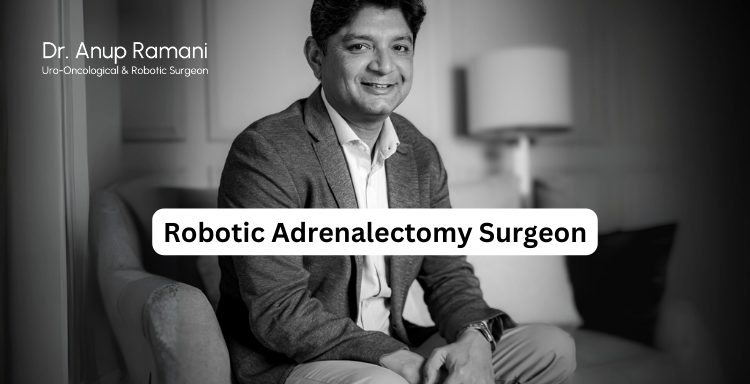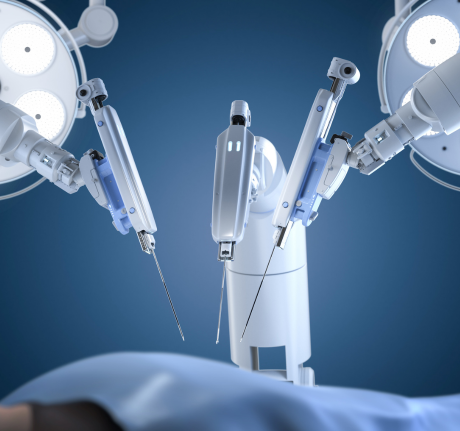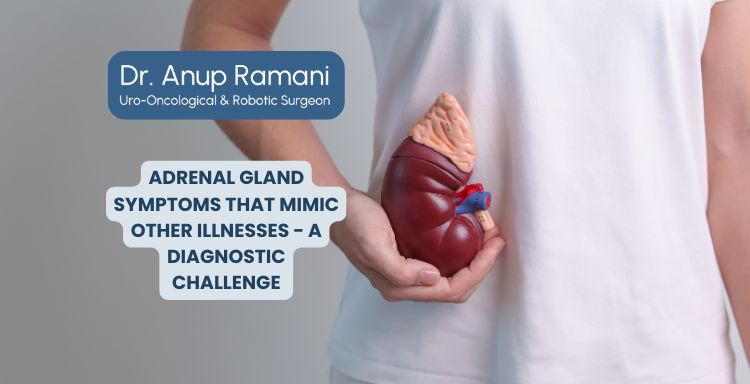Dr Anup Ramani @ Copyright 2024
By Dr. Anup Ramani
The adrenal glands, though small, play a significant role in regulating vital bodily functions. However, when the adrenal glands malfunction, the symptoms can often resemble those of other diseases, making accurate diagnosis a significant challenge for healthcare professionals. Conditions such as adrenal tumors, overactive or underactive adrenal glands and other adrenal gland disorders can manifest with symptoms that overlap with common illnesses, complicating the process of identifying the root cause.
This article delves into the diagnostic challenges posed by adrenal gland symptoms that mimic other conditions, focusing on how advanced treatments like robotic adrenalectomy and personalized care in renowned medical centers can address these challenges. We will also explore the importance of consulting an experienced adrenal gland surgeon for effective diagnosis and treatment.
Why are Adrenal Gland Symptoms Difficult to Diagnose?
Adrenal gland disorders are often challenging to diagnose because their symptoms can be attributed to a variety of other common conditions. These include:
Overlapping Symptoms with Other Illnesses
Symptoms like fatigue, weight fluctuations and high blood pressure are not unique to adrenal gland disorders and are seen in a wide range of conditions. For instance, fatigue may be mistakenly linked to stress, poor diet or sleep disorders. Similarly, weight gain and high blood pressure may be attributed to conditions like obesity or cardiovascular disease, leaving adrenal gland issues overlooked.
Lack of Specificity
Adrenal gland disorders, particularly those that involve hormonal imbalances, do not always present with distinct or easily identifiable symptoms. For example, Cushing’s syndrome, which is caused by high cortisol levels, may only manifest subtly at first, often mimicking common signs of aging or chronic stress.
The Need for Specialized Tests
Confirming an adrenal gland treatment typically requires a series of diagnostic tests, such as blood tests, imaging scans and sometimes biopsies. These tests are not always routinely performed for patients presenting with vague or non-specific symptoms, contributing to delays in diagnosis.
Co-occurrence with Other Health Conditions
Adrenal gland disorders often co-exist with other medical conditions, further complicating diagnosis. For example, a person with obesity might also suffer from an adrenal tumor or a hormonal imbalance and distinguishing between these conditions requires careful consideration of the patient’s overall health and medical history.
What Our Patients Are Saying
Diagnostic Approaches for Adrenal Gland Disorders
Blood and Urine Tests
Doctors often begin with blood and urine tests to measure hormone levels, such as cortisol and aldosterone, which can indicate adrenal gland dysfunction. These tests are crucial for diagnosing conditions like Addison’s disease, Cushing’s syndrome and pheochromocytoma.
Imaging Studies
A variety of imaging studies are used to locate and assess adrenal tumors or other abnormalities. These may include:
- CT Scans: Often used to detect tumors or abnormal growths in the adrenal glands.
- MRI Scans: Provide detailed images of soft tissues and can help identify any structural changes in the adrenal glands.
- Ultrasound: A non-invasive test that can detect larger adrenal masses.
Biopsy
In certain cases, a biopsy may be necessary to determine whether a tumor is cancerous or benign. This test involves removing a small sample of tissue from the adrenal gland and examining it under a microscope.
Robotic Adrenalectomy: A Modern Solution
In cases where surgical intervention is required, robotic adrenalectomy has emerged as a cutting-edge treatment option for adrenal gland disorders, especially for patients with adrenal tumors or conditions that require the removal of the affected gland. Robotic adrenalectomy offers numerous advantages over traditional open surgery, including reduced recovery time, minimal scarring and increased precision during the procedure.

What is Robotic Adrenalectomy?
Robotic adrenalectomy is a minimal invasive procedure that uses a robotic surgical system, such as the Da Vinci robot, to assist the surgeon in performing the adrenal gland surgery. During the procedure, small incisions are made in the abdomen, through which robotic arms are inserted to carry out the surgery with greater precision. The surgeon controls the robot remotely, providing a more refined approach to removing tumors or affected tissue.
Benefits of Robotic Adrenalectomy
- Minimal Invasive: Smaller incisions mean reduced scarring and faster healing.
- Precision: The robotic system offers a high level of precision, reducing the risk of damage to surrounding organs.
- Reduced Blood Loss: Robotic adrenalectomy is almost completely bloodless, reducing the need for transfusions.
- Faster Recovery: Most patients can return to normal activities within a few weeks after surgery.

Adrenal Gland Treatment and Post-Surgery Care
Adrenal gland surgery, particularly robotic adrenalectomy, requires careful post-operative management to ensure a smooth recovery. After the procedure, patients are typically monitored for any signs of complications and a follow-up schedule is established.
Post-Surgery Recovery
- Hospital Stay: Patients typically remain in the hospital for 3-4 days following the surgery, including the day of the procedure.
- Pain Management: The use of pain medications is common to manage discomfort in the initial recovery phase.
- Follow-Up Visits: After discharge, patients generally have follow-up consultations to ensure the recovery process is progressing as expected.
Long-Term Care and Monitoring
Follow-up appointments often include imaging scans and tests to monitor for any recurrence of adrenal disorders. For example, patients who undergo robotic adrenalectomy may need annual CT scans for up to five years after surgery to ensure that there are no signs of tumor recurrence.
Conclusion
Diagnosing adrenal gland disorders is challenging due to the nonspecific symptoms that often mimic other illnesses. However, with advancements in diagnostic techniques and surgical options like robotic adrenalectomy, patients can receive more accurate diagnoses and minimal invasive treatments. Choosing Dr. Anup Ramani, an adrenal gland surgeon, crucial for ensuring the best possible outcome, especially for complex surgeries. Early diagnosis and intervention are key to managing adrenal gland disorders effectively and improving long-term health outcomes.
FAQs
What are the most common symptoms of adrenal gland disorders?
Common symptoms include unexplained weight changes, fatigue, high blood pressure and mood swings. However, these symptoms can also be linked to other illnesses, making diagnosis challenging.
How is robotic adrenalectomy different from traditional surgery?
Robotic adrenalectomy is minimal invasive, requiring only small incisions, whereas traditional surgery often involves larger incisions. This leads to less pain, reduced scarring and faster recovery.
What is the recovery time after robotic adrenalectomy?
Most patients can resume normal activities within two weeks, with more strenuous activities like running and weightlifting being resumed after about a month.
Can adrenal gland disorders be treated without surgery?
Some adrenal gland conditions can be managed with medication, but surgery may be necessary in cases of adrenal tumors or severe hormonal imbalances.
Is robotic adrenalectomy available in India?
Yes, India, especially cities like Mumbai, offers advanced treatments like robotic adrenalectomy, performed by skilled surgeons in well-equipped hospitals.
About Author

Uro-Oncological & Robotic Surgeon
Dr. Anup Ramani is a robotic uro-oncological surgeon and an internationally recognized expert in robotic surgery for prostate, kidney and urinary bladder cancers. With more than two decades of robotic experience and 2,000+ robotic procedures, he brings unmatched precision and outcomes to complex uro-oncology cases. He is widely published in his field and is known for a personal, transparent approach-often spending over an hour in initial consultations to educate patients on its disease, surgery and recovery. His expertise spans prostate cancer treatment, kidney and bladder cancer surgery, adrenal gland surgery, kidney stone treatment, penile cancer surgery and enlarged prostate management. Dr. Ramani advocates the advantages of robotic surgery-magnified 3D vision, tremor-filtered precision, minimal scarring, lower blood loss and faster recovery-helping patients return to life sooner.
Best Uro-Oncological surgeon
Specialist in India for Robotic Surgery
MCh, DNB, MS, DNB
Dr. Anup Ramani
CONTACT
Uro-Oncologist in India,
Best Robotic Surgeon for Uro Oncology Surgery
1407, One Lodha Place Next to World Towers Senapati Bapat Marg, Worli, Mumbai. 400013.
Dr Anup Ramani @ Copyright 2024 – Website Maintenance, SEO & GEO by Opal Infotech
- Partial penectomy is done in cases where glans and distal penis is involved with carcinoma.
- Partial penectomy is a type of organ-preserving surgery. Preservation of sexual and micturational function depends on the surgical dissection and reconstruction of residual urethra.
- Patients who develop stones in the kidney or ureter, often experience severe pain.
- This condition usually needs a procedure to remove the kidney stones.
- This procedure is called ureteroscopy and is performed very commonly.
- It does not require any cuts and hence it is painless.
- The procedure is performed with an endoscope inserted through the penis under spinal anesthesia.
- The scope is inserted through the penis into the kidney and stones are dissolved with a laser.
- The procedure takes about 40-50 minutes.
- A catheter (urine pipe) is kept after the procedure to drain the bladder. A stent is kept in the kidney at the same time.
- Patient is mobile and walking in the room the same evening.
- Hospital stay is one night and patient is discharged the next day after removal of the catheter.
- Patient has to come back after six weeks to remove the stent in the kidney.
- Patients can resume office a week after surgery and heavy activities like running, weight lifting, a month after the procedure.
- We offer fixed packages for this procedure which can be obtained by calling our helpline +91 9967666060.
- Men with an enlarged prostate, which is a normal ageing changes, often experiencing difficulty passing urine. This condition usually needs a procedure to trim the prostate and relieve the blockage.
- This procedure is called TURP and is performed very commonly.
- It does not require any cuts and hence it is painless.
- The procedure is performed with an endoscope inserted through the penis under spinal anaesthesia.
- The overgrown prostate is dissolved with a laser bloodlessly.
- The procedure takes about 40 minutes.
- A catheter (urine pipe) is kept after the procedure to drain the bladder.
- Patient is mobile and walking in the room the same evening.
- Hospital stay is two nights and patient is discharged with the catheter, which is removed after 4 days.
- Patients can resume office a week after surgery and heavy activities like running, weight lifting, a month after the procedure.
- We offer fixed packages for this procedure which can be obtained by calling our helpline +91 9967666060.
-
Robotic adrenalectomy is a sophisticated, complex surgery and it is very important that an experienced surgeon performs this surgery to avoid major complications.
-
Once the anesthesia is done, and patient positioned, three micro cuts (3mm each) are made in the patient’s abdomen.
-
The arms of the Da Vinci robot are connected to the cuts via ports (tubes).
-
Dr. Ramani then sits in the controlling console to perform the surgery.
-
On an average, a robotic adrenalectomy takes one hour.
-
The surgery is almost completely bloodless and there has never been any need to transfuse blood after surgery.
-
A urine catheter and bag to drain the bladder is inserted during surgery.
-
A tiny drain pipe may be inserted in the surgical side of the abdomen, connected to a bag.
-
Patient is kept nil-by-mouth the day of the surgery, with IV fluids. Sips of water are started the next day and solid food by day three.
-
The drain pipe, if kept, is removed in the room on day 2 after surgery.
-
The catheter is removed on day two after surgery.
-
Total hospital stay for robotic adrenalectomy is 4 nights (including night before surgery).
-
Post discharge, a doctor from the surgical team visits the patient at home/ hotel room once every day.
On the day of discharge, patient is totally self-sufficient. They are able to walk freely without any pain, dress themselves, shower, toilet and they do not need to hire any nurse or help at home. Almost all patients are back to work within 2 weeks of surgery.
Heavy activities like running, weight lifting can be resumed after a month
Follow up after an adrenalectomy is in the form of CT scans, once a year for 5 years.
Local patients usually meet Dr. Ramani after two weeks to discuss report.Outstation patients are counselled on a phone consultation.
- Dr. Ramani is one of the very few surgeons in India who has the expertise to perform a robotic surgery for bladder cancer, which includes removing the urinary bladder and reconstructing a new bladder robotically.
- Robotic radical cystectomy is an extremely sophisticated, complex surgery and it is very important that an experienced surgeon performs this surgery to avoid major complications.
- Once the anaesthesia is done, and patient positioned, six micro cuts (3mm each) are made in the patient’s abdomen.
- The arms of the Da Vinci robot are connected to the cuts via ports (tubes).
- Dr. Ramani then sits in the controlling console to perform the surgery.
- On an average, a robotic radical cystectomy with an ileal conduit takes 3-4 hours.
- The surgery is almost completely bloodless and there has never been any need to transfuse blood after surgery.
- A urine catheter and bag to drain the new bladder is inserted during surgery.
- Two tiny drain pipe in inserted in the surgical side of the abdomen, connected to a bag.
- Patient is kept nil-by-mouth for 4 days after surgery with IV supplementation of patient’s daily requirements of calories, fats, carbohydrates, proteins and electrolytes.
- The drain pipes are removed in the room on day 3-5 after surgery.
- Total hospital stay for radical cystectomy is 8 nights (including night before surgery).
- Post discharge, a doctor from the surgical team visits the patient at home/ hotel room once every day.
- On the day of discharge, patient is totally self-sufficient. They are able to walk freely without any pain, dress themselves, shower, toilet and they do not need to hire any nurse or help at home.
- Almost all patients are back to work within 6 weeks of surgery. Heavy activities like running, weight lifting can be resumed after two months.
Follow up after a radical a cystectomy is in the form of CT scans, once a year for 5 years.
Histopathology report: Local patients usually meet Dr. Ramani after two weeks to discuss report.
Outstation patients are counselled on a phone consult. Depending on the report, patient may or may not need chemotherapy after surgery.
If chemo is needed, patients may choose to get it done with a medical oncologist of their choice or avail the services of one of the four medical oncologists on our team.
- Robotic partial nephrectomy is a sophisticated, complex surgery and it is very important that an experienced surgeon performs this surgery to avoid major complications. Robotic radical (total) nephrectomy is
- relatively easier but still requires significant experience to consistently deliver results.
- Once the anaesthesia is done, and patient positioned, five micro cuts (3mm each) are made in the patient’s abdomen.
- The arms of the Da Vinci robot are connected to the cuts via ports (tubes).
- Dr. Ramani then sits in the controlling console to perform the surgery.
- On an average, a robotic radical nephrectomy takes one hour and a robotic partial nephrectomy takes about an hour and half.
- The surgery is almost completely bloodless and there has never been any need to transfuse blood after surgery.
- A urine catheter and bag to drain the bladder is inserted during surgery.
- A tiny drain pipe in inserted in the surgical side of the abdomen, connected to a bag.
- Patient is kept nil-by-mouth the day of the surgery, with IV fluids. Sips of water are started the next day and solid food by day three.
- The drain pipe is removed in the room on day 3 after surgery. The catheter is removed on day two after surgery.
- Total hospital stay for radical/partial nephrectomy is 4 nights (including night before surgery).
- Post discharge, a doctor from the surgical team visits the patient at home/ hotel room once every day.
- On the day of discharge, patient is totally self- sufficient.
- They are able to walk freely without any pain, dress themselves, shower, toilet and they do not need to hire any nurse or help at home.
- Almost all patients are back to work within 2-3 weeks of surgery.
- Heavy activities like running, weight lifting can be resumed after a month.
- Follow up after a radical/partial Nephrectomy is in the form of CT scans, once a year for 5 years.
- Local patients usually meet Dr. Ramani after two weeks to discuss report.
- Outstation patients are counselled on a phone consultation.





